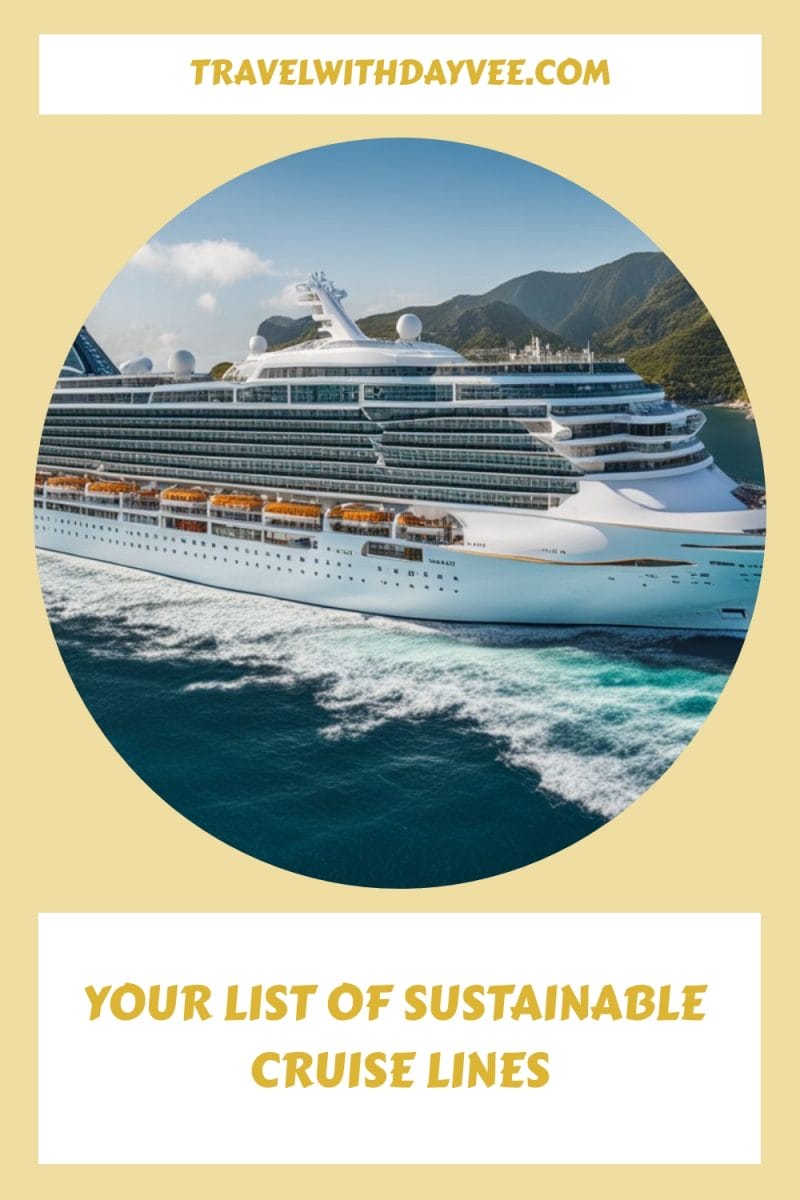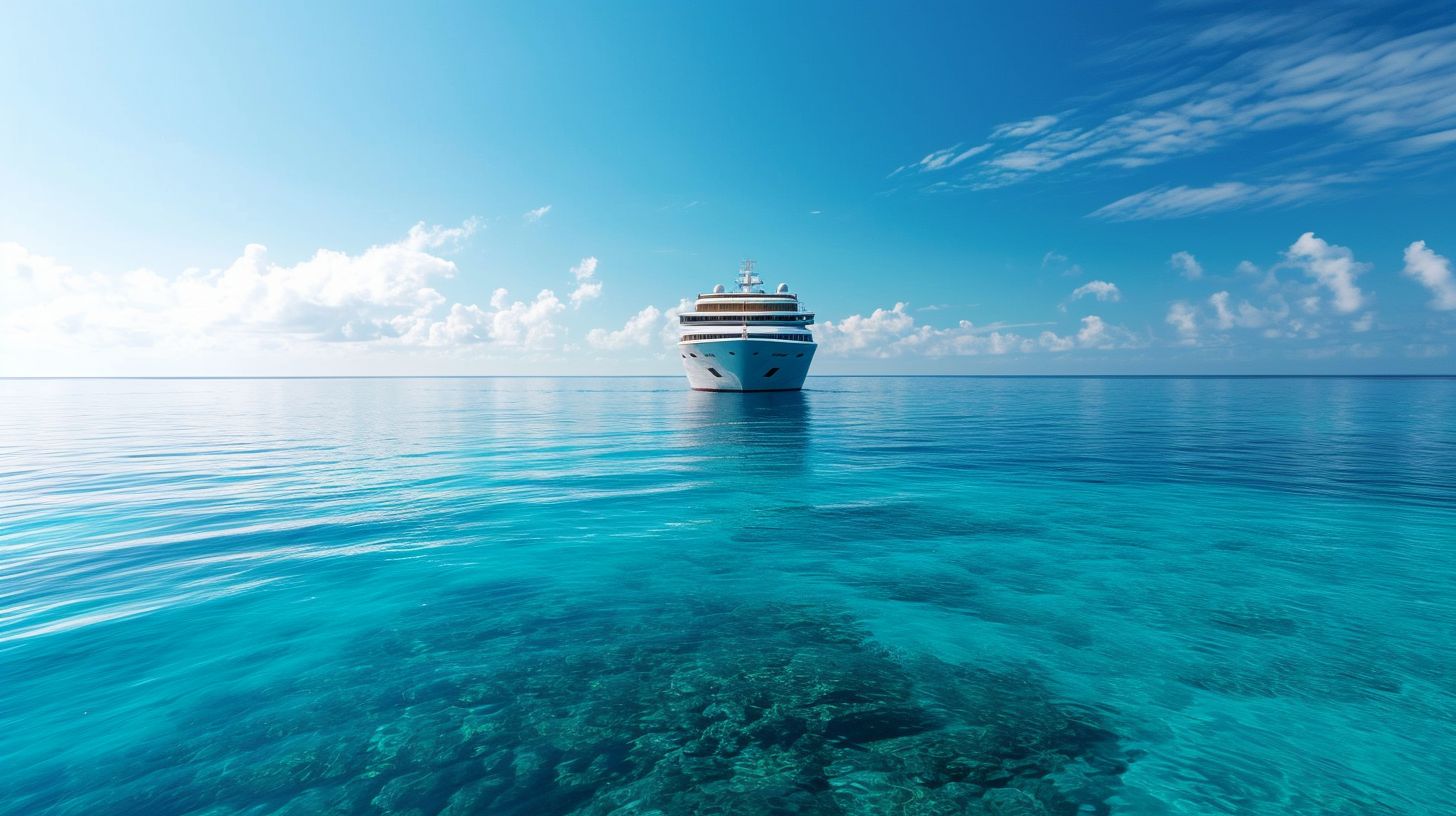
How do you solve the conflict of your love for traveling the seas, but also caring about the planet, knowing that overall the cruise industry isn’t the picture of sustainable travel?.
With the knowledge that a single cruise ship can emit as much greenhouse gas as 12,000 cars, can cruises truly achieve sustainability? This post will attempt to unpack whether it’s possible for cruising to harmonize with sustainability goals.
Key Takeaways
- Some cruise companies are embracing sustainability by building ships with hybrid engines reducing cruise emissions.
- Green marine technology such as shore power, batteries, biofuels, and green terminals are being built to help reduce the environmental impact of cruising.
- Passengers can have a role in promoting sustainable cruising by reducing waste, conserving energy on board, avoiding single-use plastics, and advocating for greener practices.
- While traditional cruises can emit as much greenhouse gas as 12,000 cars daily and contribute to marine pollution, advancements in the industry show a shift toward more ecologically responsible travel options.
- The cruise industry’s evolution towards sustainability includes plans for zero-emission ships by 2030 and investments in low-carbon fuels like methanol propulsion systems and LNG. But is that really possible?
Understanding Sustainable Tourism
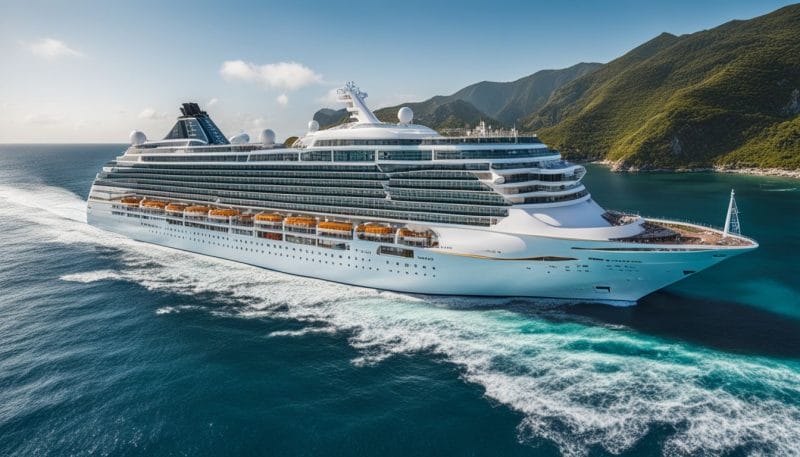
Sustainable tourism is all about exploring new places while respecting the environment and supporting local communities. It encourages you to enjoy your journey without harming natural resources or contributing negatively to climate change.
Think of it as traveling in a way that ensures destinations stay pristine and welcoming for future generations. This means engaging with cultures respectfully, minimizing waste, and choosing services that value environmental protection.
To travel sustainably on cruise ships, you need to consider how these massive vessels affect ocean health and air quality. When doing so, can you achieve the goal of reducing your carbon footprint, even when you’re sailing across the seas.
It can be possible if you look for cruises that prioritize decarbonization efforts, use alternative fuels like biofuels or LNG (liquified natural gas), or employ advanced energy-saving technologies such as hybrid engines.
Every choice towards eco-friendly cruising helps mitigate pollutants released into both the sea and sky, making a real difference in protecting our planet’s delicate marine ecosystems and limiting global warming impacts.
How Sustainable is the Cruise Industry?
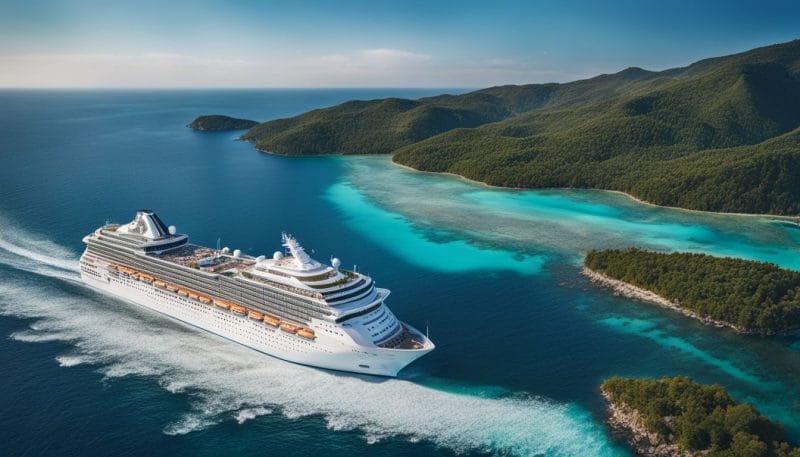
When you’re imagining the tranquil seas and exotic ports of call, it’s easy to overlook the environmental toll of cruises. Yet, as you set sail on a journey across vast oceans, it’s critical to ask whether these floating extravaganzas can navigate toward true sustainability amidst rising concerns over their ecological footprint.
Cruising Is Inherently Problematic
In the enchanting world of travel, cruises have long been celebrated for their opulence and the unique ability to whisk travelers away to multiple destinations without the hassle of constant repacking. Yet, beneath the surface of these floating palaces lies a complex web of sustainability challenges that cast a long shadow over their glossy brochures and Instagram-worthy sunsets. As a critical travel expert, it’s imperative for me to peel back the layers of luxury to reveal the environmental and social impacts that cruises have on our planet and communities.
Picture this: a single mid-sized cruise ship can guzzle up an astonishing 150 tons of fuel every day, spewing as much greenhouse gas into the atmosphere as 12,000 cars! (That’s according to a report by Nabu.) The environmental impact doesn’t stop at air pollution; these floating cities contribute significantly to marine pollution, too.
The coral reefs, those vibrant underwater havens teeming with life, face destruction from anchors alone — with places like George Town in Grand Cayman having lost around 300 acres of reef. In another incident, around 80 percent of the coral reef in Cancun, Mexico was destroyed by a Norwegian cruise ship.
Cruises don’t only just cause a loss for biodiversity but for local tourism as well. The truth is stark: though cruises offer a entry level getaway to international travel for hundreds, their carbon emissions cannot be overlooked any longer if we’re serious about tackling the climate crisis and protecting our planet’s natural beauty for future generations to enjoy.
Here’s a breakdown of the scope of pollutions cruises cause
The Carbon Footprint of Leisure: At the heart of the issue, cruise ships are floating cities with a voracious appetite for fuel, emitting staggering amounts of carbon dioxide. This not only contributes significantly to climate change but also compromises air, especially in and around bustling port cities. The romance of a sea voyage often comes at the expense of the very atmosphere we breathe.
A Plume of Pollution: Beyond carbon, the air around these vessels is thick with sulfur oxides (SOx), nitrogen oxides (NOx), and particulate matter. These pollutants are notorious for their role in acid rain and smog formation, posing a threat to both human health and the environment. The irony is palpable as passengers embark on a journey to enjoy the natural beauty that their mode of travel is harming.
The Water Beneath the Waves: The issue extends into the waters, with cruise ships generating an alarming variety of wastewater – from sewage to gray water and beyond. The inadequate treatment and disposal of these can lead to the degradation of marine ecosystems, affecting biodiversity and water quality. The vision of pristine oceans is tarnished by the reality of pollution that follows in the wake of these vessels.
Waste Management Woes: The generation of solid waste on board is another critical issue. From food waste to plastics, the management (or mismanagement) of these materials can lead to marine pollution, threatening marine life and the health of our oceans. The disconnect between the luxury onboard and the environmental cost is stark.
Disturbance and Displacement: The impact on marine life through noise, vibrations, and the risk of invasive species further complicates the narrative of cruise travel as a harmless escape. Moreover, the cultural and economic impact on local communities cannot be overlooked. The influx of tourists can lead to overcrowding, resource strain, and a dilution of local culture, often benefiting a select few rather than the community at large.
The Energy Enigma: The sheer energy consumption of cruise ships for propulsion, amenities, and more highlights the unsustainable nature of this form of travel. While the industry has made strides in adopting cleaner technologies and fuels, the journey towards true sustainability is long and fraught with challenges.
As we navigate the future of travel, it’s crucial to confront these issues head-on, advocating for responsible tourism practices that prioritize the health of our planet and its inhabitants. The allure of cruising is undeniable, but the environmental and social costs demand a reevaluation of how we choose to explore the world. The call to action is clear: it’s time for the cruise industry to chart a more sustainable course, and for travelers to weigh the impact of their voyages against the allure of the open sea.
Eco Friendly Cruise Lines
Imagine cruising the seas knowing your journey aligns with green living principles.
Is this real? Are cruise liners really steering a new course towards eco-friendly waters?
There are a few leaders in the industry that have prioritized sustainability.
As a general rule we find that cruise lines with smaller ships and smaller fleets are able to manage all aspects of what it takes to truly implement sustainable practices.
Here’s a list of our top recommended sustainable cruise line companies:
Hurtigruten
This 130-year-old Norwegian travel company pushes sustainability as its core philosophy. Leading the way in green energy, Hurtigruten eliminated HFO for its small-ship fleet more than ten years ago in favor of biofuels and marine gasoil, two other more environmentally friendly fuels.
They debuted the first hybrid battery-electric cruise ship in the world in 2019 and are currently converting the rest of their expedition fleet to hybrid battery power. By 2030, they hope to have the first zero-emission cruise ship.
They were the first cruise line to phase out single-use plastics onboard, and they’ve also enabled fleet-wide shore-power connectivity to eliminate emissions when in port.
Their avant-garde approach doesn’t stop there; their pioneering hybrid-power vessel, MS Roald Amundsen, currently sails with emissions slashed by approximately 20% compared to traditional ships.
Take a look at my trip on Hurtigruten through West Africa.
UnCruise Adventures
UnCruise Adventures distinguishes itself as a sustainable cruise company by focusing on eco-friendly practices and small-scale, intimate travel experiences that minimize environmental impact. Unlike traditional large-scale cruise lines, UnCruise operates smaller vessels that can navigate to remote and pristine areas without the same level of ecological footprint. This approach allows for more respectful wildlife encounters and promotes conservation efforts.
Furthermore, UnCruise emphasizes local and cultural immersion, supporting communities and fostering a deeper understanding and appreciation among its guests for the places they visit.
The company also implements sustainable on-board practices, such as only making enough meals for the passengers on-board. This is something I observed while cruising with them through the cost of Mexico. Reducing waste, using eco-friendly products, and promoting awareness about environmental conservation among its passengers, making it a leader in sustainable cruising.
Take a look at my trip on UnCruise Adventures through Baja California.
Havila Voyages
This is another new cruise line, that debut from Norway. Two of the four hybrid ships that this cruise company has planned have already set sail, traveling along Norway’s coastline.
With the largest passenger ship batteries at sea, Havila Voyages’ ships can travel silently and emission-free into the nation’s UNESCO-protected fjords for up to four hours.
Furthermore, the batteries are powerful enough to power the ships while they are docked and can be recharged in port using pure hydroelectric energy from the nearby grid. Even though the ships are now powered by LNG, Havila hopes to eventually operate emissions-free, with ships built to transition to hydrogen power as soon as the necessary technology is ready.
Aurora Expeditions
One of the first cruise lines to construct ships with the futuristic-looking Ulstein X-BOW—a Norwegian design that consists of an inverted bow that is pointed at the bottom and broad at the top—is Aurora Expeditions. This fuel-efficient design reduces fuel usage by up to 60% while cutting through the waves silently and with little vibration.
Aurora, an Australian company, has already received a 100% carbon neutral certification. The corporation offsets its greenhouse gas emissions by purchasing carbon credits from, say, a wind farm in Taiwan.
Explora Journeys
Summer 2024 marks the beginning of this new luxury cruise line from Swiss shipping giant MSC Group, but the real buzz will come in 2027 when it introduces the world’s first LNG-powered ship with hydrogen fuel cells and methane slip-reducing technology.
The first of two ships that Explora Journeys has planned for the nascent line, will have greatly reduced greenhouse emissions while at sea and generate little more than heat and water vapor when idle in port thanks to a partnership with Italian shipbuilders Fincantieri.
A restriction on single-use plastics and certification for underwater noise reduction (in order to protect marine life) are two other points for the company.
Ponant
With aspirations to build a “zero-impact” ship by 2025, luxury French line Ponant debuted the 245-passenger Le Commandant Charcot, an emissions-cutting hybrid adventure ship powered by electric batteries and LNG, in 2021.
Ponant is the first cruise line to be certified as Green Marine, and it also offsets all of its emissions.
In addition, the line no longer uses single-use plastics, all Ponant ships have shore-to-ship power connections while in port, and environmental impact assessments are carried out prior to itinerary construction.
The Bigger Cruise Lines say they are trying
Major players like Carnival and Royal Caribbean report that they are investing heavily in cutting-edge technology such as methanol propulsion systems and liquefied natural gas (LNG) for their latest fleet additions. But realistically, can this really reduce the wasteful culture that cruising these mega ships fosters?
Such innovations exemplify what the industry says it wants to do – shift toward low-carbon fuels, bringing us closer than ever to net-zero carbon voyages – but investigative journalists covering cruise news are not buying what cruise officials are presenting. Lily Girma, wrote for Skift “Alternative fuel sources are needed, yes. But the cruise lines’ woes go well beyond emissions and remain unaddressed.” Girma’s reporting exposes that few regulations and weak enforcement, especially when it comes to big cruise, “which commands over 90 percent of the market and is foreign-flagged, and a lack of transparency on decades of environmental woes, it’s difficult to believe this sector will meet its climate action goals as early as 2030.“
So are these companies Greenwashing?
That’s the claim of many travel industry climate and sustainability watchers. In 2023 Opportunity Green detail in thier Climate Chase Chart white paper that these large cruise companies are gaslighting the public with their sustainability claims. A few of the problems they identified are the Fossil LNG’s climate benefits “often appear to be exaggerated and advertised in a vague and general manner.” In addition to “significant information, such as fugitive methane emissions, is omitted.”
Read more about
Greenwashing
Digging Deeper into Industry Claims
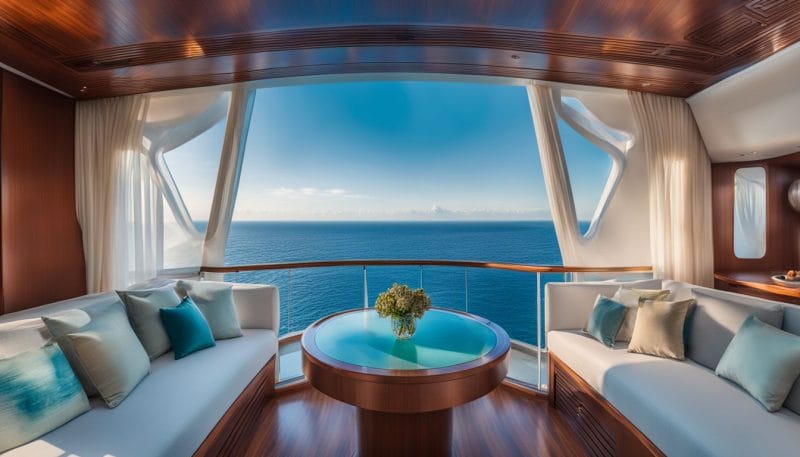
To dig deeper into what the cruise industry claims they are steering a new course toward sustainability, let’s look at more and try to understand the innovation, and eco-conscious practices they claim. Understanding that this innovation was produced in response to global environmental demands. This response language matches the increasing preference of travelers for greener options at sea.
But, as someone who has covered sustainable travel for years, you can never fully trust companies whose priority is the bottomline. The goal of capitalism is to increase profits each year, which inherently puts companies at crossroads to prioritize earnings over doing the right and ethical things.
But, let’s take a look at what the top cruise lines have reported they are doing to retrofit fleets and employ what they call cutting-edge technologies that promise cleaner voyages without sacrificing the adventure and luxury you crave.
Batteries vs. Biofuels
As the cruise industry seeks greener horizons, two key players emerge in the narrative of sustainability: batteries and biofuels. Both have the potential to reduce the environmental impact of cruising, but they bring different advantages and challenges to the high seas.
| Batteries | Biofuels |
|---|---|
| Offer a cleaner alternative to fossil fuels, with zero emissions at the point of use. | Reduce greenhouse gas emissions compared to conventional fuels, though not entirely emission-free. |
| Current technology limits storage capacity, making them less viable for long cruises. | Can be used in existing engines with minor modifications, allowing for easier integration into the current fleet. |
| High initial costs and the need for frequent recharging present economic and logistical challenges. | Derived from renewable sources, they are a more sustainable option and can be more readily scaled up. |
| Require significant investment in infrastructure, such as charging stations at ports. | Production of biofuels can compete with land use for food production and may impact food prices. |
| Innovations are underway to increase their efficiency, making them a promising option for the future. | Cruise companies are investing in new ships capable of running on methanol, a form of biofuel. |
| Not yet suitable for larger ships due to space constraints for battery storage. | Considered a transitional fuel, as they still contribute to air pollution and are not completely carbon-neutral. |
Cruise lines are exploring both options, with each having strengths and weaknesses. Batteries deliver clean energy but face significant hurdles in application. Biofuels offer a more immediate solution, yet they are not without environmental concerns. As travelers, your choices and values play a crucial role in shaping the industry’s approach to sustainability. Whether by demanding greener options or actively participating in sustainable practices while cruising, your impact extends beyond the deck of the ship, contributing to a cleaner and more responsible travel industry.
What is liquified natural gas (LNG) for Cruises
Liquified Natural Gas (LNG) for cruises represents the cruise industries biggest claim to a significant shift towards more environmentally friendly fuel options. LNG is natural gas that has been cooled down to liquid form for ease of storage and transport. When used as fuel for cruise ships, LNG has several advantages over traditional heavy fuel oil in terms of environmental impact and efficiency:
- Reduced Emissions: LNG combustion produces up to 25% less carbon dioxide than conventional marine fuels. More importantly, it virtually eliminates sulfur oxide emissions and significantly reduces nitrogen oxides and particulate matter, contributing to a drastic reduction in air pollution.
- Enhanced Efficiency: LNG can deliver higher energy efficiency compared to traditional fuels, which can lead to lower fuel consumption for the same distance traveled or power generated.
- Regulatory Compliance: With stricter environmental regulations coming into force, such as the International Maritime Organization’s (IMO) limits on sulfur content in ship fuel, LNG helps cruise lines comply with these regulations without the need for additional sulfur-reducing technologies.
- Operational Flexibility: Using LNG as fuel allows cruise ships to access ports with strict emission control requirements, thus expanding their operational flexibility and route options.
Despite these advantages, the transition to LNG also faces challenges, including the need for significant investment in new ships or retrofitting existing ones, the development of global LNG bunkering infrastructure, and considerations related to the lifecycle emissions of LNG, including methane slip. This is in addition to the other omissions cruise lines have left out for a more comprehensive and sincere move towards sustainability. Nonetheless, LNG is seen as a transitional fuel towards achieving the maritime industry’s long-term sustainability goals.
Shore Power Expansion
Shore power is like an electric lifeline for cruise ships, and idea is to allow ships to turn off their polluting engines and plug into cleaner energy sources while docked. Imagine the relief for port cities when massive vessels switch from diesel to a direct line of electricity, drastically reducing their carbon footprint and helping local air quality.
Cruise lines like Hurtigruten leading the charge by fitting ships to grid power and pioneering hybrid-power cruisers.
This move towards shore power connects directly with action on climate change efforts positioned by organizations like the International Maritime Organization (IMO). It’s more than just a temporary fix; it’s about building a sustainable network that supports renewable energy use across the shipping industry.
By investing in ports equipped with shore-side electricity, these floating giants can significantly decrease greenhouse gas emissions during their stays, showing you they’re serious about being green tourists on blue waters.
Green Terminals
Scandinavian countries tend to champion sustainability efforts by equipping ports with shoreside power facilities in the attempt to drastically cut down on pollutants while ships take a break from their voyages. Green terminals refer to port terminal facilities that are designed and operated in an environmentally sustainable manner. These terminals adopt various innovative practices and technologies to minimize their ecological footprint, reduce emissions, and enhance energy efficiency. Key features and initiatives of green terminals for cruise ports include:
- Shore Power Connectivity: Also known as “cold ironing,” this allows cruise ships to shut down their diesel engines while docked and connect to the local electricity grid, significantly reducing emissions of NOx, SOx, and particulate matter.
- Energy Efficiency: Utilizing energy-efficient technologies and designs in terminal buildings, such as solar panels for renewable energy generation and LED lighting to reduce energy consumption.
- Sustainable Infrastructure: Construction using sustainable materials and following green building certifications like LEED (Leadership in Energy and Environmental Design), ensuring the terminal buildings have a reduced environmental impact.
- Waste Management Systems: Advanced systems for managing and recycling waste generated by cruise ships and passengers, including facilities for separating and recycling different types of waste.
- Water Conservation and Treatment: Implementing systems for rainwater harvesting, water recycling, and efficient wastewater treatment to reduce water consumption and prevent pollution.
- Reduced Carbon Footprint: Efforts to lower CO2 emissions through various means, such as carbon offsetting programs and investments in clean energy projects.
- Environmental Education and Awareness: Providing information and educational materials to cruise passengers about sustainability efforts and encouraging environmentally responsible behaviors during their travels.
Private Islands
The trend of cruise lines owning private islands is a mixed bag. Talking to travelers, cruise lines spokespersons, and other professionals in the tourism industry the conclusion is that this private island model has both advantages and disadvantages, with implications for sustainability, ethics, and local communities.
Let’s walk through these ideas:
Pros
- Enhanced Guest Experience: Private islands offer a controlled environment, ensuring high-quality amenities, exclusive beaches, and unique activities tailored to cruise passengers’ preferences.
- Economic Benefits: These islands can create jobs for locals and provide a market for local goods, potentially boosting the local economy.
- Environmental Control: Cruise lines have the opportunity to implement and manage environmental sustainability initiatives on their islands, potentially leading to better conservation practices compared to less regulated areas.
- Safety and Security: A private island offers a safer, more secure environment for guests, with controlled access and well-maintained facilities.
- Cultural Programs: Some cruise lines use these islands to showcase local culture and history through performances, crafts, and excursions, providing an educational aspect to the visit.
Cons
- Economic Displacement: The creation of a private island can lead to the displacement of local and Indigenous communities or change the local economic landscape in ways that do not always benefit the original inhabitants.
- Environmental Impact: The development and operation of a private island can lead to significant environmental degradation, including habitat destruction, pollution, and increased carbon footprint.
- Limited Economic Benefits: While jobs may be created, the majority of the profits generated on private islands go back to the cruise line, and local vendors are often excluded from the economy. This is known as tourism leakage.**Learn more about tourism leakage here
- Cultural Dilution: The portrayal of local culture can sometimes be superficial or commodified, potentially misrepresenting or diluting genuine cultural heritage.
- Dependency: Local communities may become economically dependent on the cruise line, which can be problematic if the company decides to cease operations on the island.
The Sustainability and Ethics of Cruise line-owned private islands
The sustainability of cruise line-owned private islands varies widely depending on the environmental and social policies of the cruise company. For the most part, the smaller cruise lines that put sustainability at the forefront of their mission don’t have this model of owning private islands on their roadmaps. And some of the bigger cruise lines that say they have invested in sustainable practices, the jury is still out on if they ultimately prioritize development and profit over ecological and social considerations.
Ethically, the operation of private islands raises questions about equity, cultural integrity, and the balance of benefits between the cruise line and local communities. While some cruise lines make efforts to give back to local populations through employment, infrastructure improvements, and support for local businesses, others may fall short in ensuring that the local communities genuinely benefit from their presence.
The bottomline is, whether cruise line-owned private islands are sustainable and ethical depends on a range of factors, including how they are developed, managed, and integrated with the local environment and communities. A commitment to sustainable and ethical practices can help mitigate negative impacts, but this requires ongoing effort and transparency from the cruise industry.
Designing Environmentally Conscious Cruises
Currently when you board a ship you will start to see claims of moving towards sustainability. The vessels that are already using the “greener” innovations like heat recovery systems and energy-efficient lighting are reporting that they have trimmed down fuel consumption. Some have biodegradable materials to replace single-use plastics onboard, and waste management programs ensure nothing goes overboard.
But, in the fall of 2023, I was aboard a MSC Cruise along the Mediterranean, one of the big cruise lines that push sustainability as a major pillar. But nearly every day when we were at sea, I consistently saw waste overboard that was clearly from our ship. I saw it with my own eyes; and it was in a way that I have never seen on any other cruise I have been on.
One theory I had was that the passengers on that ship were not in line with proper practices. But, also, by now people should know by any means possible you should avoid throwing garage overboard into the sea.
The Role of Passengers in Sustainable Cruising
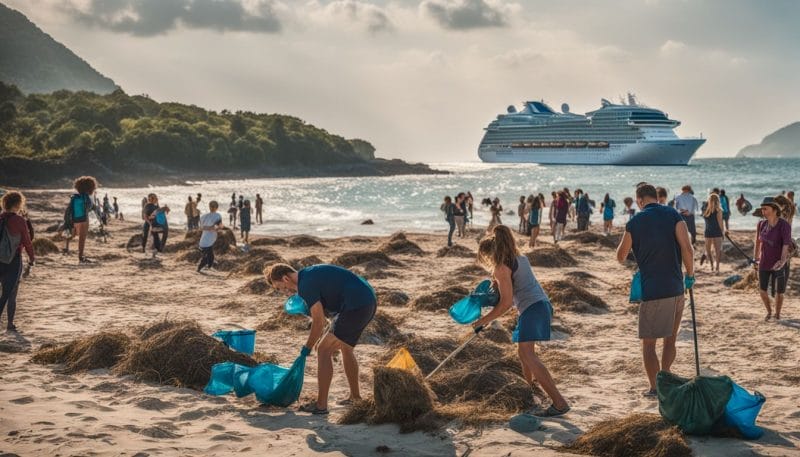
While cruising companies spearhead innovations for sustainability, your role as a passenger is pivotal—embrace it and you become an active player in the push towards more eco-conscious travel.
Engaging in mindful practices on board can significantly amplify the efforts to decarbonize the industry and lead us toward greener horizons.
Reducing Waste
Cruise vacations are a time to indulge, but they also come with responsibility. You can make a difference by cutting down on waste during your journey.
- Opt for reusable items: Bring along a refillable water bottle, coffee cup, and shopping bag to avoid single-use plastics.
- Say no to paper: Request electronic communications for boarding passes and daily schedules instead of printed versions.
- Get involved in recycling programs: Participate in the ship’s recycling initiatives by properly separating your trash.
- Reduce food waste: Take only what you can eat at buffets, and if possible, choose smaller portion options.
- Support green excursions: Choose tours that promote ecotourism and culturally sensitive experiences, which often have less environmental impact.
- Skip unnecessary souvenirs: Purchase meaningful mementos that are locally made and not mass-produced plastic goods.
- Educate yourself about ship policies: Learn about the cruise’s waste management practices and support their efforts to decarbonize operations.
- Use energy-saving options in your cabin: Make use of natural light, turn off lights when not needed, and reuse towels to lower laundry impacts.
- Advocate for change: Encourage cruise lines to adopt more environmentally friendly practices by providing feedback on their sustainability initiatives.
Energy Conservation
Energy conservation on cruise ships is shifting from an optional practice to a crucial imperative. As you traverse the seas, your actions directly influence the carbon footprint of your voyage.
- Choose itineraries on ships that prioritize energy efficiency. Vessels with advanced environmental features such as LED lighting and optimized hull designs consume less fuel, leading to lower greenhouse gas (GHG) emissions.
- Unplug electronics in your cabin when not in use. Devices left plugged in continue to draw power, contributing unnecessarily to CO2 emissions.
- Support cruise lines that invest in new technologies for emissions reduction. Companies are turning towards LNG (liquefied natural gas) which reduces the carbon intensity of their operations.
- Take advantage of shipboard programs designed to educate tourists on green practices. These initiatives often include tips on how you can be a friend of the earth, even while enjoying international travel.
- Opt for shore excursions that embody principles of responsible tourism. Excursions that emphasize local culture and environmental respect tend to have a smaller carbon footprint.
- Participate in onboard recycling efforts to reduce waste. Proper waste management lowers the energy required for disposal and helps decrease GHG emissions produced by incinerators.
- Advocate for clean shore power use at ports. Encouraging cruise liners to connect to local electrical grids when docked can considerably cut down on heavy fuel oils (HFOs) usage and related pollution.
- Limit reliance on the ship’s laundry service. Towel re – use policies and declining daily linen changes contribute substantially to energy saving onboard.
Avoiding Plastic
Plastic pollution is a major issue facing our oceans, and cruise ships can contribute significantly to the problem. As travelers, you have the power to help reduce plastic waste and make your vacations more sustainable.
- Bring reusable items: Pack a refillable water bottle, coffee mug, and shopping bags to use on board and in ports. This simple act reduces the need for single – use plastics that often end up harming marine life.
- Say ‘no’ to plastic straws: When ordering beverages, request no straw or bring your own reusable one. But, I’ve come to avoid straws altogether. You don’t need a straw to drink. Many cruise lines are phasing out plastic straws, but it’s still good practice to refuse them as they’re a common pollutant.
- Choose eco-friendly toiletries: Select products with biodegradable packaging or none at all — consider shampoo bars over bottles. Traditional toiletries can include numerous plastic components that take centuries to decompose.
- Support onboard recycling initiatives: Participate in any recycling programs your cruise offers. Properly sorting your trash ensures less ends up in landfills or, worse yet, the ocean.
- Avoid plastic-wrapped foods: Opt for fresh fruits and bulk snacks instead of individually wrapped items. Not only does this choice reduce waste, but it’s also healthier for you.
- Encourage others: You don’t have tell others and strangers what to do. No one likes that. But, by doing something from example, encourage others to join you in avoiding plastic usage. Collective action has a larger impact and can create a culture of sustainability on board.
- Communicate with cruise operators: Let them know that as a traveler, you value eco-friendly practices including reducing plastics. Customer feedback can be a powerful catalyst for change within the industry.
The Bottomline
Although cruise companies are in charge of how they run business, ultimately travelers hold the power as we can demand travel experiences that are ethical and sustainable. So can cruises truly achieve sustainability in today’s world? According to what we covered, the short answer is no. But, by taking the time to research smaller cruise lines that can realistically implement sustainable practices it seems that we can travel the seas without causing harm.
FAQs
1. Are there any eco-friendly options for cruise ships?
Yes. We have laid out a list of our recommended cruise companies in this article.
2. What efforts are cruises making to become more sustainable?
The larger cruise companies have claims for sustainability that cannot be verified as a path to real change in the industry. But looking for small cruise lines, with smaller ships and fleets, you can see their sustainability efforts in practice, due to the smaller scale.
3. How does boat travel compare with other forms of transport in terms of sustainability?
While traditional boats pollute, new tech is paving the way for hybrid or fully electric cars on water, aiming for a cleaner mode of travel akin to an electric car’s reduced emissions on land.
4. Is it possible for cruise lines to operate without harming marine life?
Yes. The cruise lines from our recommended list (above in this article) all have naturalists on board and practice environmentally friendly practices that minimize ship strikes and protect the animals of the sea.
5. Does achieving sustainability mean we might see totally carbon-free cruises soon?
The goal is ambitious, but companies do need to aggressively try to plan for their companies to provide carbon-free cruising experiences.

